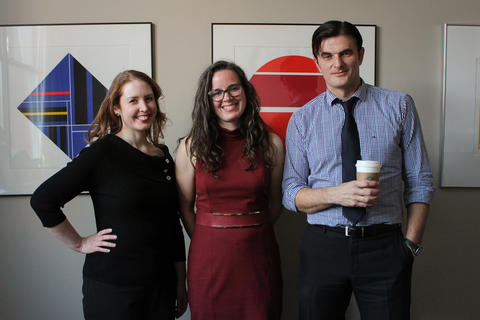Blogrige
The Official Baldrige Blog

Cord the elephant arrives on the campus of UW-Stout in 2002.
Take your pick of two stories here: how the University of Wisconsin–Stout continues modeling key concepts of the Baldrige Excellence Framework since winning the nation’s most prestigious award for organizational excellence 17 years ago. Or how an elephant ended her escape from the circus at the campus of the high-performing university—perhaps also inspired to take a journey to excellence.
If you’re eager to find out about the elephant, read on. First let’s focus on the role-model public university. In recent years, we have posted two interviews of UW–Stout leaders to share updates on the organization’s use of the Baldrige framework to improve and excel. Those previous blogs highlighted the organization’s innovative strategic planning process and its annual campus engagement process (“You Said, We Did”) that celebrates faculty and staff members’ improvement ideas.
At the Baldrige Program’s upcoming Quest for Excellence® Conference in Baltimore, MD, presenters from the UW–Stout will again present their best practices based on the Baldrige Excellence Framework/Education Criteria for Performance Excellence. Responding to a few questions about that presentation, Amanda Brown, Meridith Wentz (formerly Drzakowski), and Andrei Ghenciu jointly conveyed the information below.

Brown is a professor in UW–Stout’s Department of Communication Studies, Global Languages, and Performing Arts and a member of the university’s Strategic Planning Group; she applies the Baldrige Education Criteria for Performance Excellence to ensure continuous improvement of instruction. Andrei Ghenciu is an associate professor of mathematics in the university’s Department of Mathematics, Statistics and Computer Science; and Wentz is an assistant chancellor in the university’s Department of Planning, Assessment, Research, and Quality. Wentz has served since 2011 on the national board of examiners for the Malcolm Baldrige National Quality Award and has been a senior examiner since 2014; she has presented UW-Stout’s approach to data-based decision making at numerous institutional research, assessment, and Baldrige conferences.
Would you please briefly describe what attendees will learn at your organization’s session at the Baldrige Program’s upcoming Quest for Excellence Conference?
Brown, Wentz, and Ghenciu:
Higher education institutions often lack systematic processes to use their data to build new knowledge to use in strategy development, a challenge frequently faced by any type of large organization. The upcoming presentation by Dr. Jeff Sweat, Dr. Amanda Brown, and Dr. Andrei Ghenciu from the University of Wisconsin–Stout (UW–Stout) will share how our 2001 Baldrige Award-winning university has used the Baldrige framework to create a systematic framework for aligning data, strategic planning, and decision making. Specifically, Drs. Sweat, Brown, and Ghenciu will provide examples of how our university applies the Baldrige framework to both academic and administrative processes, as well as how we use a balanced scorecard to compile and communicate institutional data to aid in our strategic planning process.
What are some examples of how your university benefits from this concept?
Brown and Wentz :
The University of Wisconsin–Stout applies the Baldrige Criteria in a variety of areas that benefit the organization. Specifically, the Baldrige framework has helped the university streamline and focus metrics, provide a mechanism to integrate suggestions and feedback from all sectors within the organization, and facilitate communication and professional development.
One such example is the university’s continual assessment of courses and academic programs as well as the non-academic units that support the university, such as financial aid and university housing. Recently, those involved in submitting reports assessing those areas provided input about that process. Specifically, feedback indicated that reports could be streamlined and done more frequently as well as better integrated into existing processes. University administrators reflected on this information and integrated the feedback about the deployment of those assessment reports into the university’s processes, which helps internal stakeholders feel heard and valued.
Please share your top tips for introducing or sustaining use of the Baldrige Excellence Framework (which includes the Criteria for Performance Excellence) to promote an organization’s success?
Wentz and Ghenciu:
- Start small. You can introduce the Baldrige framework into one process within one unit of the organization. You don’t need to start with the intent that you are planning to apply for the award.
- Connect with someone who has experience with the Baldrige framework. In UW–Stout’s case, we were introduced to the framework by a person who was on our alumni board and was also serving as a judge for the Baldrige Program. He helped explain how using the framework would add value to our institution, and he also helped us understand that our values were already in alignment with the Baldrige framework.
- Emphasize the non-prescriptive nature of the framework. Communicate to everyone in the organization that adopting the Baldrige framework is about focusing on performance excellence and enhancing processes that align with areas of importance to the institution. It is not about introducing new reporting requirements, producing lengthy reports, or telling people how they should be doing their jobs.
What do you view as key reasons or ways that organizations in your sector can benefit from using the Baldrige framework?
Wentz and Brown:
Public funding for higher education is increasingly performance-based, as demonstrated by the fact that performance-based funding initiatives exist in 32 states and are being developed in an additional six states. However, there are limited models for managing performance-based funding effectively and limited models that align metrics with areas of importance to the institutional mission, vision, and values. Additionally, institutions use data and information to demonstrate accountability to the students and the public; however, the number of accountability initiatives and metrics continues to grow, making it difficult to know which data are important. The Baldrige framework offers a roadmap for identifying key organizational characteristics, aligning them with processes and results, and focusing on success.
Further, not only does the University of Wisconsin–Stout apply the Baldrige framework to specific academic and administrative processes, but it also utilize the framework to make students and university employees feel valued and included. For example, the university revamped its processes for obtaining input and feedback from students and employees. Formerly “listening sessions,” the new “Engagement Sessions” are open to everyone and very well-attended. Ideas, suggestions, and even complaints are recorded and then integrated into the strategic planning process.
Traditionally, strategic planning and assessment are considered administrative functions. However, the University of Wisconsin–Stout includes a variety of voices in the strategic planning process in addition to administrators, such as students, university staff, faculty, and external stakeholders. The university does not just include faculty in strategic planning meetings and assessment process though; it also seeks to involve them in professional development opportunities, such as the Baldrige Quest for Excellence Conference, to include their voices and perspectives. This approach to include more voices and perspectives in the strategic planning process not only increases the quality of the planning process but also builds morale and starts to build bridges among the various silos that are often a hallmark of organizations like universities.
What would you say to a group of college students (particularly those pursuing graduate studies for a career in higher education) about the Baldrige framework?
Ghenciu:
I would tell the students about the core values of the Baldrige framework, and I would emphasize and ethics and transparency. I think that, very early in the career of someone in higher education, respect for ethics and transparency is essential and any wrong step in this direction (e.g., plagiarism, incorrect results submitted for publication, not giving the correct references, etc.) could take years to be fixed. Ultimately, failing to act with ethics and transparency would lead to a lack of respect from one's peers, and it would make it almost impossible for the individual to promote and publish his or her work.
Visionary leadership is inspiring. Inspiration takes place in poetry, music, mathematical research, and any area in higher education. Following visionary leadership or being a visionary leader could be great ingredients for success.
Last, but not least, I can’t speak enough about valuing people. It is a core value that we should integrate in every single other core value of the Baldrige framework. Valuing your colleagues, your leader, and most important, your students is a vital recipe for success.
When did you first hear about the Baldrige framework? What were your initial thoughts or “aha” moments as you began learning about it?
Brown:
When I was hired as a faculty member at the University of Wisconsin–Stout in 2005, I often heard about the Baldrige Award. But I did not learn about the award criteria until much later, as I began to learn about academic assessment and strategic planning as a tenured professor. Although I knew that this award was presented for quality, learning that the focus of the award was for the organization’s processes in addition to outcomes demonstrated to me a commitment to continual reflection, learning, and improvement. I find the University of Wisconsin–Stout’s commitment to integrating as many voices as possible into that process of continual development inspiring. Everyone—including students, the faculty, the support staff, administrators—are invited to provide feedback, and that feedback is actually used.
Ghenciu:
I first heard about the Baldrige framework when I applied to become an assistant professor of mathematics in the Department of Mathematics, Statistics and Computer Science at the University of Wisconsin–Stout in the fall of 2013. Knowing that UW–Stout, as a 2001 Baldrige Award recipient, was the first higher education institution to receive this highest honor, naturally I did more research to find out more about the institution I was hoping to join.
After I got and started the job at UW–Stout that fall, my interest in the Baldrige framework and its core values grew even higher. One core value of the Baldrige framework that created an “aha” moment for me is that of valuing people. It wasn’t until I received the Research Fellow Award in the fall of 2015, my third year at UW–Stout, that I fully understood how vital this value is. The award that I received had a great impact on my research and on my career; it meant that I had more time to pursue my research projects, and I was able to start at least three as well as finding new collaborators. In addition, as recipient of the university’s Emerging Outstanding Researcher Award in the spring of 2016, I can say that it is a great feeling to work for an institution that values its people—and to really feel like you are valued.
Do you have any funny story or anecdotes that you’re willing to share about your experience as a Baldrige Award recipient?
Brown and Wentz:
Yes. In 2002, the University of Wisconsin–Stout faced a crisis. Two elephants, Tory and Cord, mother and daughter, escaped from a local circus. Mom Tori was quickly captured, but six-year-old Cord trekked through the city of Menomonie, eluding emergency vehicles. Cord’s chase ended at the UW–Stout campus, where her trainer used a second elephant to calm her.
Perhaps Cord wanted to visit campus because she knew that UW–Stout had recently overcome its own crises, such as streamlining over 250 performance metrics used in the strategic planning process to a manageable 25 and transitioning from a centralized planning process to one in which everyone has the opportunity to be included. These process changes, in addition to many others, are what led to UW–Stout becoming the first (and still the only) four-year, comprehensive higher education institution to receive the Baldridge Award.
As if Cord’s high-speed chase (by Asian elephant standards) through the city was not headline-grabbing enough, another 2002 story may have overshadowed UW–Stout’s Baldrige Award win in the media, as well: Luke Helder, the Midwest Pipe Bomber and UW–Stout student, made headlines across the nation when he planted mailbox bombs across the country with the intent to create a smiley face. Thankfully, there were no fatalities in the bombings, and Helder was apprehended before his diabolical plan could be completed. While explosions and high-speed chases will always top the headlines, our hope at UW–Stout is that the legacy of the Baldrige Award and the framework will endure.
COME. LEARN. NETWORK. ENGAGE.

Quest for Excellence® Conference
BALTIMORE | April 8–11, 2018
Join us for the 30th Anniversary Quest for Excellence Conference showcasing the best practices of the 2017 Baldrige Award recipients!
AWARD CEREMONY
Sunday, April 8
Join us Sunday evening for the Award Ceremony and Dinner honoring the 2017 recipients.





